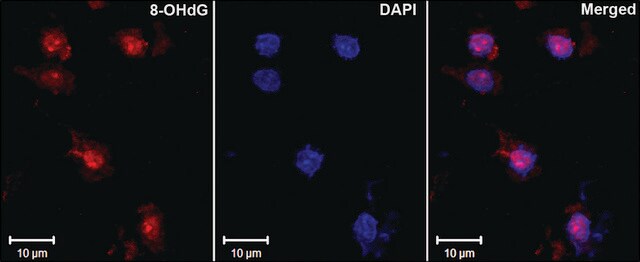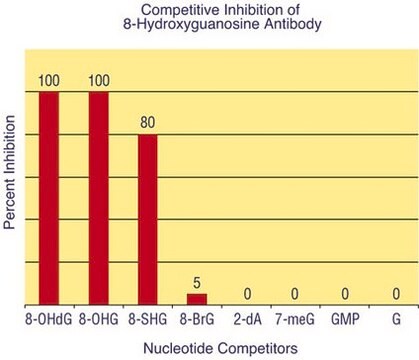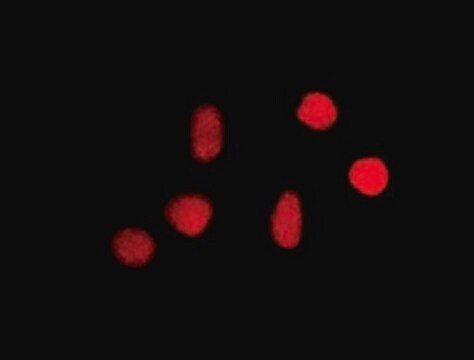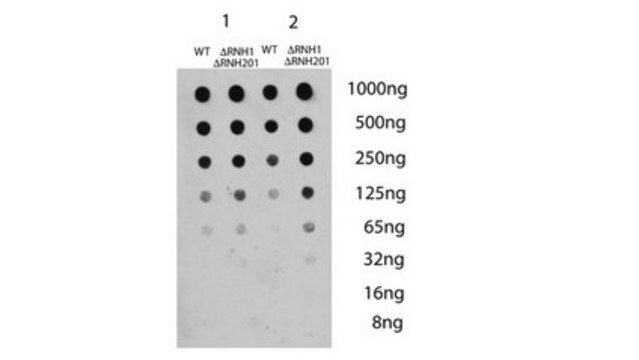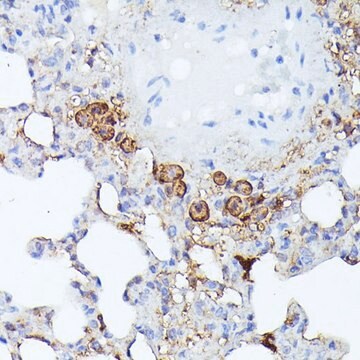MAB3560-C
Anti-8-Oxoguanine, clone 483.15 Antibody (Ascites Free)
clone 483.15, from mouse
Sinonimo/i:
8-Oxoguanine
About This Item
Prodotti consigliati
Origine biologica
mouse
Livello qualitativo
Forma dell’anticorpo
purified immunoglobulin
Tipo di anticorpo
primary antibodies
Clone
483.15, monoclonal
Reattività contro le specie
rat, human, monkey, bovine, mouse
Reattività contro le specie (prevista in base all’omologia)
all
tecniche
ELISA: suitable
immunocytochemistry: suitable
immunohistochemistry: suitable
Isotipo
IgMκ
Condizioni di spedizione
dry ice
modifica post-traduzionali bersaglio
unmodified
Informazioni sul gene
human ... OGG1(4968)
Descrizione generale
Specificità
Immunogeno
Applicazioni
Immunohistochemistry Analysis: A representative lot detected increased nuclear 8-oxoguanine (8-oxoG) immunoreactivity in paraffin-embedded coronal hippocampus sections from mice induced to express mutated mitochondrial isoform Uracil–DNA glycosylase by fluorescent immunohistochemistry (Lauritzen, K.H., et al. (2011). DNA Repair (Amst). 10(6):639-653).
Immunohistochemistry Analysis: A representative lot detected significantly increased nuclear 8-oxoguanine (8-oxoG) immunoreactivity in ovaries excised from neonatal mice upon exposure to ovotoxic agent 4-vinylcyclohexene diepoxide (VCD), methoxychlor (MXC), or menadione (MEN) in culture by fluorescent immunohistochemistry (Sobinoff, A.P., et al. (2010). Toxicol. Sci. 118(2):653-666).
Immunocytochemistry Analysis: A representative lot detected significantly increased 8-oxoguanine (8-oxoG) immunoreactivity in RINm5F rat insulinoma cells upon IL-1beta or ROS-inducer menadione treatment (Mehmeti, I., et al. (2011). Biochim. Biophys. Acta. 1813(10):1827-1835).
Immunocytochemistry Analysis: A representative lot detected significantly increased nuclear 8-oxoguanine (8-oxoG) immunoreactivity in AC16 human cardiomyocytes upon infection by the hemoflagellate protozoan parasite Trypanosoma cruzi (Ba, X., et al. (2010). J. Biol. Chem. 285(15):11596-11606).
Immunocytochemistry Analysis: Representative lots detected nutrient-deprivation-induced enhancement of nuclear 8-oxoguanine (8-oxoG) immunoreactivity in HeLa and COS-7 cells by fluorescent immunocytochemistry (Conlon, K.A., et al. (2003). DNA Repair (Amst). 2(12):1337-1352; Conlon, K.A., et al. (2000). J. Histotechnol. 23(1):37-44).
ELISA Analysis: Specificity of a representative lot against 8-oxoguanine was confirmed by competitive ELISA. Competition by dGMP, dAMP, dCMP or TMP was only observed when the concentrations were increased to the millimolar range.
Qualità
Immunocytochemistry Analysis: A 1:50 dilution of this antibody detected 8-Oxoguanine in HeLa cells.
Linkage
Stato fisico
Altre note
Non trovi il prodotto giusto?
Prova il nostro Motore di ricerca dei prodotti.
Codice della classe di stoccaggio
12 - Non Combustible Liquids
Classe di pericolosità dell'acqua (WGK)
WGK 2
Punto d’infiammabilità (°F)
Not applicable
Punto d’infiammabilità (°C)
Not applicable
Certificati d'analisi (COA)
Cerca il Certificati d'analisi (COA) digitando il numero di lotto/batch corrispondente. I numeri di lotto o di batch sono stampati sull'etichetta dei prodotti dopo la parola ‘Lotto’ o ‘Batch’.
Possiedi già questo prodotto?
I documenti relativi ai prodotti acquistati recentemente sono disponibili nell’Archivio dei documenti.
Il team dei nostri ricercatori vanta grande esperienza in tutte le aree della ricerca quali Life Science, scienza dei materiali, sintesi chimica, cromatografia, discipline analitiche, ecc..
Contatta l'Assistenza Tecnica.